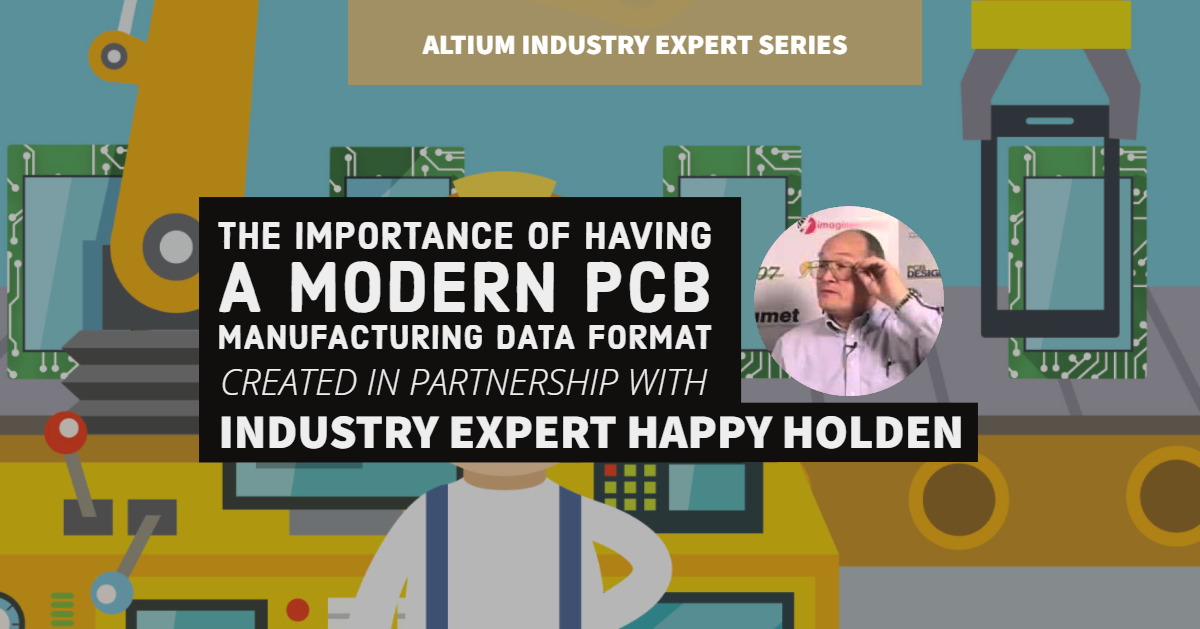The Importance of Having A Modern PCB Manufacturing Data Format

Table of Contents
I recently posted a BLOG on Altium about the latest eSmart Factory in New Hampshire. Using the latest in State-of-the-Art machinery and processes, it can produce near-perfect complex multilayers and HDI substrates with extremely fine geometries in only a few days, and without ever being helped or touched by human hands, all while and emitting nothing to harm the environment—zero effluents.
Digitization for the Smart Factory
This technology will shape the ways printed circuits are manufactured for years to come. The advantage it has with being an ‘All-Digital Smart Factory’ is also its potential weakness. There are no workers to read a particular recipe blueprint or adjust any machines! This is an “All-Digital-Smart-Factory” and it needs digital recipes for everything. Enter the IPC-2581 digital design communication program. As seen in Figure 1, the IPC-2581 program committee is creating a digital thread that will enable design tools to output a digital XML file that can drive the ‘Factory of the Future’ or the Smart Factory.
FIGURE 1: Digitization of design characteristics for the Smart Factory. (Source: 2017 IPC APEX presentation)
IPC-2581-the DMPC
The evolving standard IPC-2581 is one reason that the IPC-CFX-2591 Standard was developed so rapidly. The design-to-manufacturing standard has been an IPC focus for nearly 30 years. The CAD-to-CAM data transfer has been one of multiple files, specifications and notes, as seen in Figure 28. First it was Gerber -> EDIF -> IPC-D-350 -> ODB -> GenCam -> ODB++ -> IPC-2541 -> GenCam 2.0 -> GenCamX -> IPC-2581A and now IPC-2581B w/extensions. But the digitization of all product and manufacturing information has compelled the industry to create a universal, open, product standard and the IPC-2581B is the closest thing we have to a consensus standard. Highlighting that fact is the rapid implementation of CFX.
Progress has been rapid on IPC-2581 but focused on electronics assembly. The heavily process and CNC requirements for PCB fabrication has taken a backseat. As seen in Figure 2, several data requirements have not been digitized yet.
The current state of PCB fabrication is characterized by this situation:
- PCB Fabrication Factory Capability
- PCB technology ranges from ML, HDI, SLP and FPC
- High mix, low to high volume, with hundreds of active customers (>15,000 designs/year)
- Customer Data
- high reliability and specification compliance customer base
- >10 languages (English and simplified Chinese are most common)
- no customers where all designs match factory capability or their specifications
- many customers have some designs with no DFM TQ’s being required
- English and metric units (sometimes in same document package)
- average >1 pre-design DFM review per tooled design
- Front-end Tooling
- significant amount of capacity required for pre-design DFM reviews and internal ECN’s
- designs provided as CAD files, Gerber 274X, ODB++ and IPC-2581
- front-end is required to note/resolve when design violates customer specifications
FIGURE 2: IPC-2581’s goal is the complete digitization of the PCB product into a data-driven standard. But a number of areas have, as yet, not been addressed by 2581. [Source: KORF Consultancy]
The ‘Connected Factory for Assembly’-IPC-CFX & Hermes
IPC-CFX is an OPEN Network Standard introduced by the Institute for Connecting Electronic Industries (IPC) in 2018 (Figure 3). It establishes three critical elements for “plug-and-play” industrial IoT:
- A message Protocol-using AMQP.
- An encoding mechanism-using {JSON}.
- A specific content creation element-structured topics and messages.
The new standard was created very quickly with the involvement of over 300 industrial firms all working together. It is:
- a standard to enable Industry 4.0 but free and OPEN source;
- IIoT ‘plug & play”;
- open to all, with consensus-based agreements of >300 participants;
- machines, processes, systems and humans;
- no licensing, contracts or dependencies, with DIY software and aides;
- Current focus is all discrete assembly manufacturing;
- Published April 2019.
FIGURE 3: IPC-CFX is an OPEN, free M2M electronic assembly protocol standard. [Source: IPC]FIGURE 3: IPC-CFX is an OPEN, free M2M electronic assembly protocol standard. [Source: IPC]
The Hermes Standard (THS) is a low-level line control protocol that passes information up and down the equipment line:
- PCB-ID
- Program Name
- Key product data
These elements allow for the creation of automatic decision making, dashboard displays, alerts and report. Applications that improve productivity, efficiency, capacity planning and quality while lowering costs. It allows the full traceability of components (IPC-1782) and feedback to design (IPC-2581).
The IPC has established a methodology to add/edit new messages for the CFX Standard, the “CFX Message Submission Process”, to allow it to grow and be applied by more machines and processes. There is even CFX messaging for hand soldering.
Artificial Intelligence to the Rescue
Late in 1995, Hewlett-Packard Laboratory developed a ‘self-learning artificial intelligence’ that could assist PCB designers in their complex job of designing high-speed multilayers. The AI System was called ‘EXPLOYER’ and worked in conjunction with earlier software, ‘The Board Construction Adviser’ that provided PCB Fab process information and costs. The system is shown in Figure 4 and emphasizes that AI can come to the rescue to provide needed information for the digitization of electronics manufacturing.
These topics are part of the video of the Keynote delivered at AltiumLive in 2019 and can be seen on YouTube.
FIGURE 4: HP Lab’s Design Explorer working with BCA-IPDA and EDA CAD tools to design high-speed multilayers
Have more questions? Call an expert at Altium or discover more about PCB data Management and how it interrelates to the PCB Design process and roles of everyone involved.


